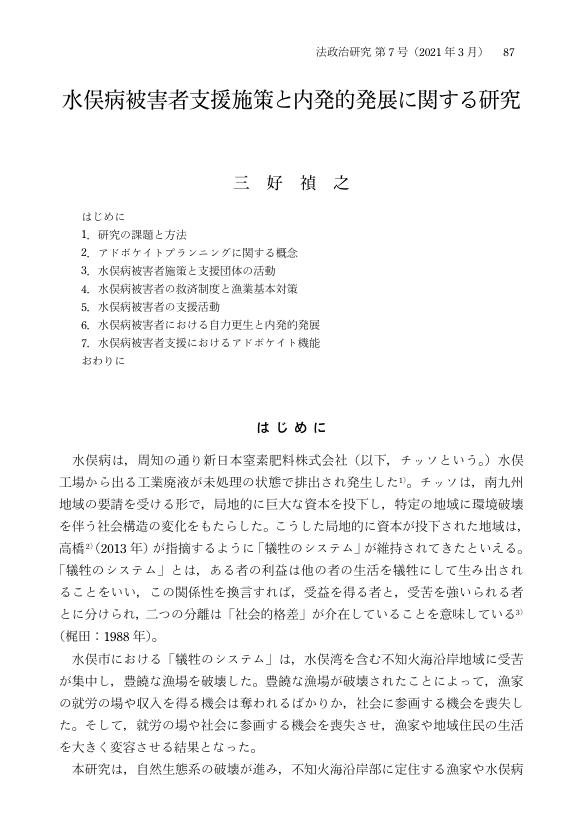2 0 0 0 OA 水俣病多発地域における漁家世帯の階層移動と 克服への究明
- 著者
- 三好 禎之
- 出版者
- 日本法政学会
- 雑誌
- 法政論叢 (ISSN:03865266)
- 巻号頁・発行日
- vol.53, no.1, pp.201, 2017 (Released:2017-05-19)
Overview After 1956, when Minamata disease was officially acknowledged, interdisciplinary research was developed that included epidemiology, sociology, ethnology, and social welfare. However, longitudinally and cross-sectionally qualitative research into how the lives of Minamata disease victims have been damaged by pollution remains scarce. Furthermore, qualitative research that has explored social stratum movements of Minamata disease victims has thus far yet to be undertaken, and the actual situation is unclear. Against this background, the present study has sought to elucidate social stratum movements of fishery households through an exploratory approach, and investigates how they have overcome having their lives destroyed, and how they have escaped from a state of worsening poverty. The study also examines how legislation and policy have contributed to the lives of Minamata disease victims.
2 0 0 0 OA ホームレスの健康と自立への生活環境整備の課題(2)
- 著者
- 三好 禎之
- 出版者
- 日本法政学会
- 雑誌
- 法政論叢 (ISSN:03865266)
- 巻号頁・発行日
- vol.49, no.2, pp.14, 2013 (Released:2017-11-01)
1 0 0 0 OA 水俣病被害者支援施策と内発的発展に関する研究
- 著者
- 三好 禎之
- 出版者
- 関西法政治研究会
- 雑誌
- 法政治研究 (ISSN:21894124)
- 巻号頁・発行日
- vol.7, pp.87, 2021 (Released:2021-06-01)
1 0 0 0 OA 指定介護老人福祉施設における夜間介護労働の構造実態(1)
- 著者
- 三好 禎之
- 出版者
- 名古屋柳城短期大学
- 雑誌
- 研究紀要 (ISSN:13427997)
- 巻号頁・発行日
- vol.27, pp.131-143, 2005-12-20
今日の指定介護老人福祉施設(以下:施設)を利用する入居者の要介護度や認知度は総体的に高い傾向を示している。2002年、老人福祉施設協議会(老施協)が行った「特別養護老人ホーム運営概況調査」によると、施設入居者の平均要介護度は3.53度を示していた。この要介護度より入所者状況をみると、「寝たきり」の入居者は68.3%に及び、入居者の日常生活における自立度は低い傾向にある。本調査対象施設においても、2002年4月より2005年10月までの要介護度の平均を年度別にみると、2002年3.46度、2003年3.66度、2004年3.79度、2005年10月現在3.72度と推移し、要介護度は年々高い傾向となっている。以上のように、施設入居者の身体や精神の状態は、重度化している傾向にあると考えられる。こうした現状に対して、施設介護業務の提供時間や提供頻度は、主要介護業務を中心として部分的に増加していくことが予測できる。また入所者の要介護状態に併せて、介護業務の提供時間を見定めることや、介護業務の編成など状況に即した介護業務の確立は急務であるといえよう。取り分けて、夜間という時間帯は、限られた人員配置で行われており、1人の介護職員が提供する介護業務の時間や頻度は、これまで以上に増加傾向を示すと考えられる。これらのことから、本研究は、施設に勤務する介護職員の夜間介護業務実態を1分間のタイムスタディで持って観察し、夜間介護業務課題と夜勤者の主要介護業務を明らかにした。


